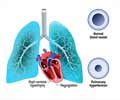New research out of University of California San Francisco is suggesting that mortality remains high among patients with pulmonary arterial hypertension awaiting lung transplant
New research out of University of California San Francisco is suggesting that mortality remains high among patients with pulmonary arterial hypertension awaiting lung transplant, despite changes to the allocation system that were designed to reduce mortality and increase the equitable distribution of donor organs.
The study is reported in the September 1 issue of the American Journal of Respiratory and Critical Care Medicine, published by the American Thoracic Society.Until just a few years ago, the amount of time that a given patient had been on the waiting list was the only factor in determining his or her priority, but in 2005, a new allocation system based on a "lung allocation score" (LAS), was implemented. LAS is determined in part by the patient's functional status, exercise capacity, lung function, hemodynamic data and the need for ventilatory support.
Overall, mortality on the lung transplant waiting list has fallen as a result of the changes, especially among those with chronic obstructive pulmonary disease (COPD), idiopathic pulmonary fibrosis (IPF) and cystic fibrosis (CF); patients with idiopathic pulmonary arterial hypertension (IPAH), however, make up only a small minority of lung-transplant candidates, and therefore little is known about whether and how they have benefited from the changes to lung allocation protocols.
"Most people will agree that the LAS has improved organ allocation for most patients on the waiting list, but we wished to study how it has specifically affected patients with idiopathic pulmonary arterial hypertension (IPAH)—a condition for which the LAS may not adequately capture the severity of the patient's illness," said Hubert Chen, M.D., M.P.H., assistant professor of medicine at UCSF and lead author of the study.
To investigate the question, Dr. Chen and colleagues obtained data for all lung transplant registrants in the U.S. listed between May 4, 2002, and May 3, 2008. They simultaneously examined two outcomes—death versus transplant—for the nearly 8,000 registrants diagnosed with COPD, IPF, CF or IPAH and compared the "Pre-LAS" period (from May 4, 2002 to May 3, 2005) to the "post-LAS" (from May 4, 2005 to May 3, 2008.)
They were not surprised to find that implementation of LAS was associated with an overall increased likelihood of transplantation and decreased risk of death. However, further analysis revealed that the risk of death for each individual disease except IPAH decreased significantly.
Advertisement
"The fact that the LAS has led to an overall improvement in the time to transplantation is not particularly surprising," noted Dr. Chen. "But we would hope that those changes would have positively affected all lung transplant candidates, whereas we found distinct differences in the impact according to disease, particular for pulmonary arterial hypertension."
Advertisement
"The LAS has had a positive impact on the majority of wait-listed patients in the U.S.," wrote Kevin Chan, M.D., of the University of Michigan, in an accompanying editorial. "Although the overall likelihood of transplantation has increased and wait-list mortality has fallen, Chen and colleagues show that patients with IPAH are relatively disadvantaged by the current system. Equity of donor lung allocation in the era of LAS is not quite there yet."
Source-Eurekalert
RAS













